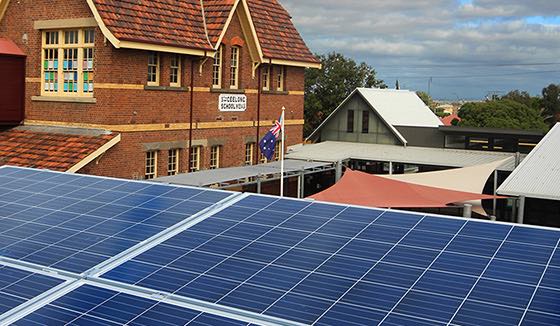
Federal Labor has unveiled plans to create a virtual power plant of solar schools across Australia, through $1 billion government loans scheme that would help schools to invest in rooftop panels and/or battery storage.
The Solar Schools program, announced on Tuesday, would allocate up to $1 billion in Clean Energy Finance Corporation funds to provide concessional loans for the purchase – or upgrade – of both solar panels and battery systems, either by schools or VPP project developers.
The idea is not only to slash the power costs of schools –by between $89,000 and $120,000 annually for large schools around the country, as estimated in the table below – but to use the network of solar and battery systems to deliver electricity and other services to the grid.
Labor leader Bill Shorten said the program would first be trialled through two to three VPPs across different regions, ahead of a full rollout taking in up to 4,000 schools and supporting up to 364MW of VPP capacity.
The scheme would use a number of different VPP models, too, in a bid to drive competition and innovation, and offer choice to schools.
“Schools are an excellent location for solar investment and the creation of virtual power plants, because they often don’t use energy at times of peak demand and through a large portion of summer,” Shorten said in a statement.
“Schools are largely vacant for more than 150 days per year. Often demand for energy is highest when kids are not at school.
“This makes schools perfect locations for solar and battery powered VPPs [virtual power plants], to support grid reliability and lower power prices for Australian families and business.”
Indeed, as the CEO of energy software developer Enosi Steve Hoy told One Step Off The Grid in March, schools have struggled to justify investing in solar, for the same reasons that make them well-suited for solar trading.
His company, in partnership with electricity retailer Energy Locals, is in the midst of setting up an energy sharing platform which, among other things, would provide access to solar for consumers otherwise unable to invest in the technology.
The plan is to allow customers – like the local primary school – to negotiate the sale of excess rooftop solar generation at rates individually agreed upon with chosen buyers.
In this way, Enosi and Energy Locals hope their platform will take pressure off the grid and – for consumers – eradicate hidden fees.
“If (schools) can sell (their) excess solar to the parents, then you’ve got this natural marketplace and the parents are likewise supporting the school,” Hoy said.
“In the same way, at the middle of the day, when the school’s energy needs are highest, they can buy from the parents, who are mostly out at work.”
As the Labor proposal notes, schools taking part in the scheme would not only save money on electricity bills by using their own cheap solar power, but – depending on the specific VPP model – by earning a revenue stream from selling power and other services to the grid.
On top of that, participation in the scheme would provide teaching opportunities for students, about renewable energy and storage technology, and modern energy systems.
Shorten said the program would also have strict requirements about product, installer and maintenance standards that will need to be met, including compliance with the National Construction Code and the Clean Energy Council installation guide.
“All batteries installed will have to meet both the strict Australian Standard and the Clean Energy Council’s best practice guide, which requires certification against a range of international product standards,” the statement said.

Sophie is editor of One Step Off The Grid and deputy editor of its sister site, Renew Economy. Sophie has been writing about clean energy for more than a decade.



